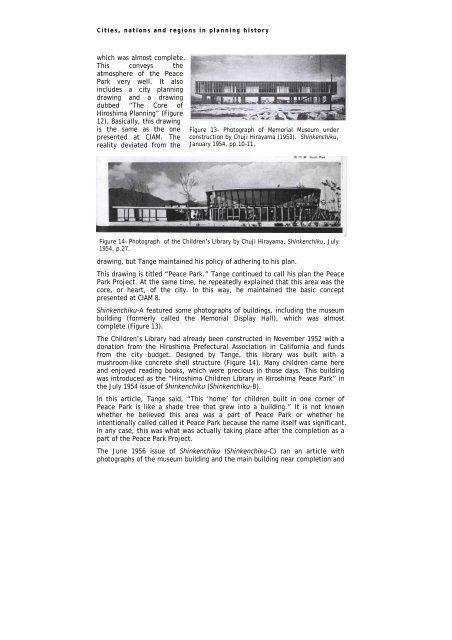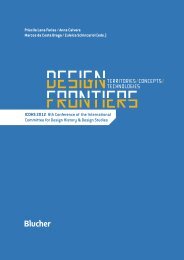changes in plannig zone of hiroshima peace memorial park ... - USP
changes in plannig zone of hiroshima peace memorial park ... - USP
changes in plannig zone of hiroshima peace memorial park ... - USP
Create successful ePaper yourself
Turn your PDF publications into a flip-book with our unique Google optimized e-Paper software.
Cities, nations and regions <strong>in</strong> plann<strong>in</strong>g history<br />
which was almost complete.<br />
This conveys the<br />
atmosphere <strong>of</strong> the Peace<br />
Park very well. It also<br />
<strong>in</strong>cludes a city plann<strong>in</strong>g<br />
draw<strong>in</strong>g and a draw<strong>in</strong>g<br />
dubbed “The Core <strong>of</strong><br />
Hiroshima Plann<strong>in</strong>g” (Figure<br />
12). Basically, this draw<strong>in</strong>g<br />
is the same as the one<br />
presented at CIAM. The<br />
reality deviated from the<br />
Figure 13- Photograph <strong>of</strong> Memorial Museum under<br />
construction by Chuji Hirayama (1953). Sh<strong>in</strong>kenchiku,<br />
January 1954, pp.10-11.<br />
Figure 14- Photograph <strong>of</strong> the Children’s Library by Chuji Hirayama, Sh<strong>in</strong>kenchiku, July<br />
1954, p.27.<br />
draw<strong>in</strong>g, but Tange ma<strong>in</strong>ta<strong>in</strong>ed his policy <strong>of</strong> adher<strong>in</strong>g to his plan.<br />
This draw<strong>in</strong>g is titled “Peace Park.” Tange cont<strong>in</strong>ued to call his plan the Peace<br />
Park Project. At the same time, he repeatedly expla<strong>in</strong>ed that this area was the<br />
core, or heart, <strong>of</strong> the city. In this way, he ma<strong>in</strong>ta<strong>in</strong>ed the basic concept<br />
presented at CIAM 8.<br />
Sh<strong>in</strong>kenchiku-A featured some photographs <strong>of</strong> build<strong>in</strong>gs, <strong>in</strong>clud<strong>in</strong>g the museum<br />
build<strong>in</strong>g (formerly called the Memorial Display Hall), which was almost<br />
complete (Figure 13).<br />
The Children’s Library had already been constructed <strong>in</strong> November 1952 with a<br />
donation from the Hiroshima Prefectural Association <strong>in</strong> California and funds<br />
from the city budget. Designed by Tange, this library was built with a<br />
mushroom-like concrete shell structure (Figure 14). Many children came here<br />
and enjoyed read<strong>in</strong>g books, which were precious <strong>in</strong> those days. This build<strong>in</strong>g<br />
was <strong>in</strong>troduced as the “Hiroshima Children Library <strong>in</strong> Hiroshima Peace Park” <strong>in</strong><br />
the July 1954 issue <strong>of</strong> Sh<strong>in</strong>kenchiku (Sh<strong>in</strong>kenchiku-B).<br />
In this article, Tange said, “This ‘home’ for children built <strong>in</strong> one corner <strong>of</strong><br />
Peace Park is like a shade tree that grew <strong>in</strong>to a build<strong>in</strong>g.” It is not known<br />
whether he believed this area was a part <strong>of</strong> Peace Park or whether he<br />
<strong>in</strong>tentionally called called it Peace Park because the name itself was significant.<br />
In any case, this was what was actually tak<strong>in</strong>g place after the completion as a<br />
part <strong>of</strong> the Peace Park Project.<br />
The June 1956 issue <strong>of</strong> Sh<strong>in</strong>kenchiku (Sh<strong>in</strong>kenchiku-C) ran an article with<br />
photographs <strong>of</strong> the museum build<strong>in</strong>g and the ma<strong>in</strong> build<strong>in</strong>g near completion and
















